Difference between revisions of "Mamiya Six III"
(→Focussing Gearing) |
(fixed link coding) |
||
| Line 33: | Line 33: | ||
==Lens and shutter combinations== | ==Lens and shutter combinations== | ||
*[[Kajiro_Kōgaku|K.O.L.]] Sola Special Anastigmat f/3.5 75mm | *[[Kajiro_Kōgaku|K.O.L.]] Sola Special Anastigmat f/3.5 75mm | ||
| − | **in [[Compur|COMPUR]]-RAPID (B, 1-500th) shutter<ref> | + | **in [[Compur|COMPUR]]-RAPID (B, 1-500th) shutter<ref>[http://neco.aki.gs/neco99/neco30/00/mamiya/03/0300500.html Neco's Mamiya Site] </ref> |
| − | ** in [[NKS]]-TOKIO (B, T, 1-200th) shutter<ref> | + | ** in [[NKS]]-TOKIO (B, T, 1-200th) shutter<ref>[http://page4.auctions.yahoo.co.jp/jp/auction/d110780810 November 2010)|Yahoo Auction, seen December 2010]</ref> |
*[[Kajiro_Kōgaku|K.O.L.]] Special f/3.5 75mm | *[[Kajiro_Kōgaku|K.O.L.]] Special f/3.5 75mm | ||
| − | **in DABIT-SUPER (B, 1-500th) shutter<ref> | + | **in DABIT-SUPER (B, 1-500th) shutter<ref>[http://neco.aki.gs/neco99/neco30/00/mamiya/03/031112.html Neco's Mamiya Site] </ref> |
| − | **in GINREI KOHKI VESTER-3 (B, 1-200th) shutter<ref> | + | **in GINREI KOHKI VESTER-3 (B, 1-200th) shutter<ref>[http://neco.aki.gs/neco99/neco30/00/mamiya/03/03111c.html Neco's Mamiya Site] </ref> |
| − | **in [[NKS]]-TOKIO (B, T, 1-200th) shutter<ref> | + | **in [[NKS]]-TOKIO (B, T, 1-200th) shutter<ref>[http://neco.aki.gs/neco99/neco30/00/mamiya/03/031114.html Neco's Mamiya Site] </ref> |
| − | **in Orient A shutter<ref> | + | **in Orient A shutter<ref>[http://neco.mediacat-blog.jp/c2702_2.html Neco's Mamiya site] </ref> |
** in TYS -II (B, T, 1-200th) shutter<ref> sn#17170—Photographica Collection Dirk HR Spennemann </ref> | ** in TYS -II (B, T, 1-200th) shutter<ref> sn#17170—Photographica Collection Dirk HR Spennemann </ref> | ||
* [[Schneider]] Xenar f/3.5 75mm | * [[Schneider]] Xenar f/3.5 75mm | ||
| − | **in F. DECKEL MÜNCHEN [[Compur|COMPUR]] RAPID (T, B, 1-300th) shutter<ref> | + | **in F. DECKEL MÜNCHEN [[Compur|COMPUR]] RAPID (T, B, 1-300th) shutter<ref>[http://www.flickr.com/photos/garww/2092718840/in/pool-998914@N24/|Flickr image] </ref> |
: <br> <br> | : <br> <br> | ||
| Line 76: | Line 76: | ||
=Post war versions= | =Post war versions= | ||
| − | Immediately after Japan's surrender, Mamiya sought to return to Tokyo and recommence camera production. This was facillitated in October 1946 by a major order placed by the Central Purchasing Office of SCAP. When production restarted after the war, some examples of the Mamiya Six III may well have assembled been from spare parts. Soon after, however, new bodies were machined, which have slight design variations compared with the pre-War and War-time bodies (→ technical details). These post-war versions can most readily be distinguished by the use of Takatiho Tokio [[Zuiko]] f/3.5 75mm lenses; these lenses, which were later replaced with [[Olympus]] [[Zuiko]] badged versions, were designed in post-World War II and first released in 1946.<ref>See the lens chronology on the [[ | + | Immediately after Japan's surrender, Mamiya sought to return to Tokyo and recommence camera production. This was facillitated in October 1946 by a major order placed by the Central Purchasing Office of SCAP. When production restarted after the war, some examples of the Mamiya Six III may well have assembled been from spare parts. Soon after, however, new bodies were machined, which have slight design variations compared with the pre-War and War-time bodies (→ technical details). These post-war versions can most readily be distinguished by the use of Takatiho Tokio [[Zuiko]] f/3.5 75mm lenses; these lenses, which were later replaced with [[Olympus]] [[Zuiko]] badged versions, were designed in post-World War II and first released in 1946.<ref>See the lens chronology on the [[Zuiko]] page.</ref>. |
Full production recommenced in January 1946, when the first 57 units were delivered. Additional orders were placed by the Japan Trade Agency for bartered exports.<ref>''Mamiya. A History of Innovation. Mamiya 50th Anniversary''. Produced by the Mamiya-History of Innovation Editorial Committee. Bunkyo-ku, Tokyo: Mamiya Camera Co. Ltd. p. 4.</ref> An English language manual for the Mamiya Six with a printing date of November 1946 depicts a Mamiya Six III but does not give much additional detail regarding lenses.<ref>Photographica Collection Dirk HR Spennemann</ref> | Full production recommenced in January 1946, when the first 57 units were delivered. Additional orders were placed by the Japan Trade Agency for bartered exports.<ref>''Mamiya. A History of Innovation. Mamiya 50th Anniversary''. Produced by the Mamiya-History of Innovation Editorial Committee. Bunkyo-ku, Tokyo: Mamiya Camera Co. Ltd. p. 4.</ref> An English language manual for the Mamiya Six with a printing date of November 1946 depicts a Mamiya Six III but does not give much additional detail regarding lenses.<ref>Photographica Collection Dirk HR Spennemann</ref> | ||
The fact that so far far no Mamiya Six III units have been noted which carry the engraving "[[Made in Occupied Japan]]" on the bottom, suggests that the production of the Mamiya Six III halted before the issuance of SCAPIN 1535 in February 1947.<ref>See the entry [[Made in Occupied Japan]] for background.</ref> Yet, advertising for the camera continued until December 1947 (→[[Mamiya Six III#Advertisements| Advertisements]]). Either these were surplus stocks, or units inscribed with [[Made in Occupied Japan]] have gone unpublicised. | The fact that so far far no Mamiya Six III units have been noted which carry the engraving "[[Made in Occupied Japan]]" on the bottom, suggests that the production of the Mamiya Six III halted before the issuance of SCAPIN 1535 in February 1947.<ref>See the entry [[Made in Occupied Japan]] for background.</ref> Yet, advertising for the camera continued until December 1947 (→[[Mamiya Six III#Advertisements| Advertisements]]). Either these were surplus stocks, or units inscribed with [[Made in Occupied Japan]] have gone unpublicised. | ||
| Line 83: | Line 83: | ||
== Technical details == | == Technical details == | ||
| − | :Post War versions of the Mamiya Six III are very similar to the prewar versions. They have a [[Mamiya_Six_Design_Variations#Flash Shoe | cold shoe for the flash]] which is affixed by two screws set diagonally; and a [[Mamiya_Six_Design_Variations#Depth of Field Indicator| depth of field indicator]] ranging from 3.5 to 22. The encased, more elaborate droplet shaped [[Mamiya_Six_Design_Variations#Frame Counter | frame counter]] of the war-time versions is replaced by a simple broad arrow.<ref>In essence the design goes back to that of the [[Mamiya I]].</ref> The [[Mamiya_Six_Design_Variations#Knobs and Struts| film winding knob]] is now mush-room-shaped. The directional arrow at the [[Mamiya_Six_Design_Variations#Focus Wheel| focus wheel]] has a filled head and only shows infinity as a direction. Minor differences are a stronger [[Mamiya_Six_Design_Variations#Door Catch Variations|internal door catch]] and a different shape to the shutter release side of the [[Mamiya_Six_Design_Variations#Front Door Variations| front door]]. In addition, the protruding tripod socket is a slightly flatter than the pre-war models. | + | :Post War versions of the Mamiya Six III are very similar to the prewar versions. They have a [[Mamiya_Six_Design_Variations#Flash Shoe | cold shoe for the flash]] which is affixed by two screws set diagonally; and a [[Mamiya_Six_Design_Variations#Depth of Field Indicator| depth of field indicator]] ranging from 3.5 to 22. The encased, more elaborate droplet shaped [[Mamiya_Six_Design_Variations#Frame Counter | frame counter]] of the war-time versions is replaced by a simple broad arrow.<ref>In essence the design goes back to that of the [[Mamiya Six I]].</ref> The [[Mamiya_Six_Design_Variations#Knobs and Struts| film winding knob]] is now mush-room-shaped. The directional arrow at the [[Mamiya_Six_Design_Variations#Focus Wheel| focus wheel]] has a filled head and only shows infinity as a direction. Minor differences are a stronger [[Mamiya_Six_Design_Variations#Door Catch Variations|internal door catch]] and a different shape to the shutter release side of the [[Mamiya_Six_Design_Variations#Front Door Variations| front door]]. In addition, the protruding tripod socket is a slightly flatter than the pre-war models. |
| Line 97: | Line 97: | ||
==Lens and shutter combinations== | ==Lens and shutter combinations== | ||
* [[Nikon|Nippon Kogaku]] [[Nikkor]] f/3.5 75mm | * [[Nikon|Nippon Kogaku]] [[Nikkor]] f/3.5 75mm | ||
| − | **in F. DECKEL MÜNCHEN [[Compur|COMPUR]] RAPID (T, B, 1-300th) shutter<ref> | + | **in F. DECKEL MÜNCHEN [[Compur|COMPUR]] RAPID (T, B, 1-300th) shutter<ref>[http://www.flickr.com/photos/rebollo_fr/3625576602/in/pool-46195334@N00/|Flickr image]] </ref> |
* [[Olympus| Takatiho]] Tokio [[Zuiko]] f/3.5 75mm | * [[Olympus| Takatiho]] Tokio [[Zuiko]] f/3.5 75mm | ||
| − | **in [[Compur|COMPUR]]-RAPID (B, 1-500th) shutter<ref> | + | **in [[Compur|COMPUR]]-RAPID (B, 1-500th) shutter<ref>[http://picasaweb.google.com/kheims/CraigslistAndEbay#5356646212296282242 Web page] </ref> |
** in KŌNAN-RAPID (B, 1-300th) shutter<ref> sn#24763—Photographica Collection Dirk HR Spennemann </ref> | ** in KŌNAN-RAPID (B, 1-300th) shutter<ref> sn#24763—Photographica Collection Dirk HR Spennemann </ref> | ||
| − | ** in [[NKS]] (B, T, 1-200th) shutter<ref> | + | ** in [[NKS]] (B, T, 1-200th) shutter<ref>[http://neco.aki.gs/neco99/neco30/00/mamiya/03/03111g.html Neco's Mamiya site] </ref> |
| − | ** in [[Seikosha|SEIKOSHA]]-RAPID (B, 1-500th) shutter<ref> | + | ** in [[Seikosha|SEIKOSHA]]-RAPID (B, 1-500th) shutter<ref>[http://neco.aki.gs/neco99/neco30/00/mamiya/03/03111b.html Neco's Mamiya site] </ref> |
* Tōwa Kōki Neocon f/3.5 75mm (July 1947— ) | * Tōwa Kōki Neocon f/3.5 75mm (July 1947— ) | ||
** in [[Copal|COPAL]] (B, 1-300th) shutter<ref> sn#25585—Photographica Collection Dirk HR Spennemann </ref> | ** in [[Copal|COPAL]] (B, 1-300th) shutter<ref> sn#25585—Photographica Collection Dirk HR Spennemann </ref> | ||
| − | ** in T-MERIT shutter<ref> | + | ** in T-MERIT shutter<ref>[http://nelsonfoto.com/SMF/index.php?action=printpage;topic=12471.0 Web page] </ref> |
* T.S.M. Anastigmat f/3.5 75mm | * T.S.M. Anastigmat f/3.5 75mm | ||
| − | **in [[Copal|COPAL]] (B, 1-300th) shutter<ref> | + | **in [[Copal|COPAL]] (B, 1-300th) shutter<ref>[http://neco.aki.gs/neco99/neco30/00/mamiya/03/03111a.html Neco's Mamiya site] </ref> |
| − | ** in [[NKS]]-TOKIO (B, T, 1-200th) shutter<ref> | + | ** in [[NKS]]-TOKIO (B, T, 1-200th) shutter<ref>[http://www.auctiondeals.ca/detail_product/150470493227/mamiya_six/|Sales advertisement, seen December 2010]] </ref> |
| − | ** in T-MERIT shutter<ref> | + | ** in T-MERIT shutter<ref>[http://senior.nikkosen.net/cameralist.html Web page] </ref> |
Revision as of 11:34, 22 December 2010
| PLEASE DO NOT LINK THIS PAGE UNTIL FINISHED--MY SANDBOX IS OVERFLOWING |
Contents
History
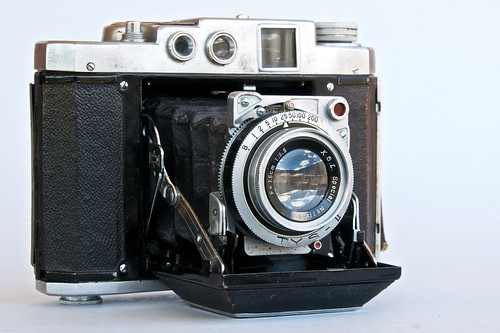
|
| Mamiya Six III (war-time version) (sn 17170) Image by Dirk HR Spennemann. (Image rights) (Image rights) |
Mamiya Six Model III is unique inasmuch as its straddles World War II. Announced in March 1940, [1] before the outbreak of the Pacific War, the camera was produces as long as possible until the factory had to be moved from Tokyo in March 1945. Because the Mamiya Six seems to have been the first camera to have been ordered by the Central Purchasing Office of SCAP,[2] full scale production of the Mamiya Six III resumed in January 1946, when 46 units were delivered.[3]
War-time version
The camera was announced in February 1941[4] and introduced to the market in ¶¶ 1942[5] During the war, production volumes seem to have increased, twice necessitating an enlargement of the factory, first in February 1942 and then again in February 1944[6] In March 1944, Mamiya opened a secondary production facility at Tokyo University for the grinding and assembly of lenses.[7] The production of the Mamiya Six III was halted in March 1945, when the Mamiya factory had to be relocated from Tokyo to the intensified U.S. bombing raids.[8]
Technical details
Like the Mamiya I, the camera was fitted with a double exposure warning system, comprised of a small transparent, red coloured half-pane that would appear in the rangefinder window. At least the post war version has a shutter release lock that prevented accidental double exposure.[9] Double exposure warning mark in viewfinder. Flash contact.
The Pre-War Versions of the Mamiya Six III are built-identical with the Mamiya Six I, but have a slightly smaller waist level finder (10 x10 mm) window on the top late, while the round viewfinder window on the front has a smooth edge. The shutter release button now has a slight depression (dimple) in the top and the frame counter is encased in the shape of a droplet. The guide rail for the removable pressure plate runs for the length of the film gate and now exhibits an embossed directional arrow. The eyelets for a neck strap, which had been part of the Mamiya Six I design, have been omitted.
Dimensions
- 145 x 107 x 55 mm closed (107 mm open) ; weight: 820g[10]
Lens and shutter combinations
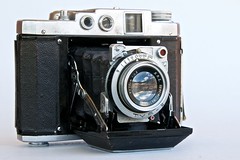
|
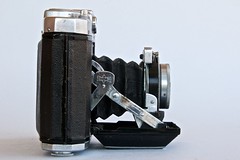
|
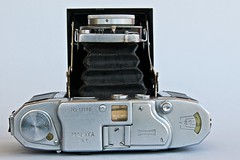
|
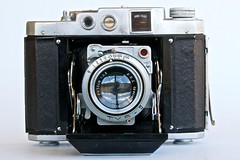
|
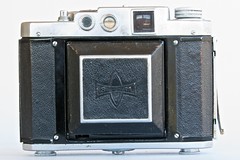
|
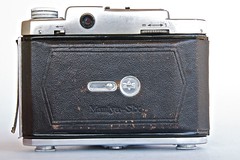
|
| War-time version of the Mamiya Six Model III with K.O.L. Special f/3.5 75mm in TYS -II (B, T, 1-200th) shutter. Images by Dirk HR Spennemann. (Image rights) | ||
Focussing Gearing
 |  Design July 1939[19] |
 |  Design October 1940[20] |
| Focussing Gearing of the Mamiya Six. Comparison of patent drawings with actual examples. Patent scans edited copies of IJPL images; camera images by Dirk HR Spennemann. (Image rights) | |
Post war versions
Immediately after Japan's surrender, Mamiya sought to return to Tokyo and recommence camera production. This was facillitated in October 1946 by a major order placed by the Central Purchasing Office of SCAP. When production restarted after the war, some examples of the Mamiya Six III may well have assembled been from spare parts. Soon after, however, new bodies were machined, which have slight design variations compared with the pre-War and War-time bodies (→ technical details). These post-war versions can most readily be distinguished by the use of Takatiho Tokio Zuiko f/3.5 75mm lenses; these lenses, which were later replaced with Olympus Zuiko badged versions, were designed in post-World War II and first released in 1946.[21]. Full production recommenced in January 1946, when the first 57 units were delivered. Additional orders were placed by the Japan Trade Agency for bartered exports.[22] An English language manual for the Mamiya Six with a printing date of November 1946 depicts a Mamiya Six III but does not give much additional detail regarding lenses.[23] The fact that so far far no Mamiya Six III units have been noted which carry the engraving "Made in Occupied Japan" on the bottom, suggests that the production of the Mamiya Six III halted before the issuance of SCAPIN 1535 in February 1947.[24] Yet, advertising for the camera continued until December 1947 (→ Advertisements). Either these were surplus stocks, or units inscribed with Made in Occupied Japan have gone unpublicised.
Technical details
- Post War versions of the Mamiya Six III are very similar to the prewar versions. They have a cold shoe for the flash which is affixed by two screws set diagonally; and a depth of field indicator ranging from 3.5 to 22. The encased, more elaborate droplet shaped frame counter of the war-time versions is replaced by a simple broad arrow.[25] The film winding knob is now mush-room-shaped. The directional arrow at the focus wheel has a filled head and only shows infinity as a direction. Minor differences are a stronger internal door catch and a different shape to the shutter release side of the front door. In addition, the protruding tripod socket is a slightly flatter than the pre-war models.
Variant A
- single raised button to release the front door catch
Variant B
- twin buttons to release the front door catch
Dimensions
- 146 x 108 x 50mm closed (106 open); weight: 827g[26]
Lens and shutter combinations
- Nippon Kogaku Nikkor f/3.5 75mm
- Takatiho Tokio Zuiko f/3.5 75mm
- Tōwa Kōki Neocon f/3.5 75mm (July 1947— )
- T.S.M. Anastigmat f/3.5 75mm
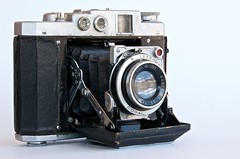
|

|
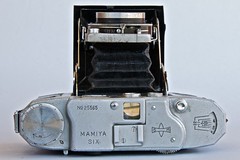
|

|
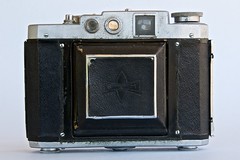
|

|
| Post-war version of the Mamiya Six Model III with Tōwa Kōki Neocon f/3.5 75mm in COPAL (B, 1-300th) shutter. Images by Dirk HR Spennemann. (Image rights) | ||
  
|
  
|
| Post-war version of a Mamiya Six III no.23875, COMPUR shutter (T, B, 1–300), Nikkor 7.5cm f/4.5 lens no.75183. Pictures courtesy of eBayer badman664. (Image rights) |
Brochures and Manuals
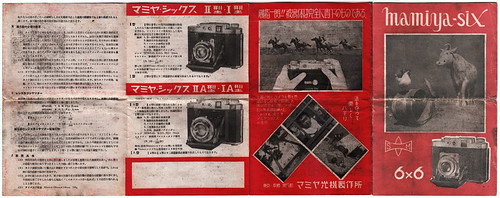
|
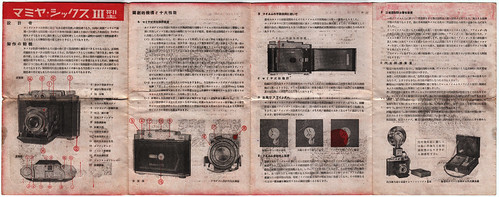
|
| War-Time Brochure for the Mamiya Six III (with reference to the Mamiya Six I, IA, II and IIA) Images by Dirk HR Spennemann. (Image rights) | |

|
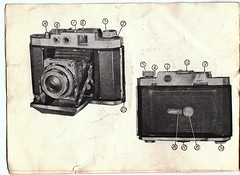
|
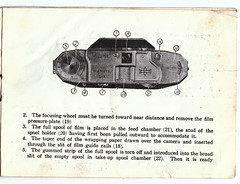
|
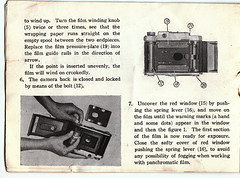
|
| Post-War instruction Booklet for the Mamiya Six III (selective pages only) Images by Dirk HR Spennemann. (Image rights) | |||
Advertisements
 Advert by Kōseisha in Shashin Kagaku (写真科学) Jan 1944 |
 Advert by Nisshindō in Shashin Kagaku (写真科学) Jan 1944 |
 Advert by Nihon Diamond in Shashin Kagaku (写真科学) Jan 1944 |
 Advert in Nihon Shashin (日本写真) Jan-Feb 1944 |
 Advert by Kōseisha in Shashin Kagaku (写真科学) Jan 1944 |
 Advert by Nihon Diamond in 'Shashin Kagaku (写真科学) Feb & Jul 1944 |
 Advert by Matsuzakaya in Shashin Kagaku (写真科学) Jan-Feb 1944 |
 Advert by Hongō Shinbidō in Shashin Kagaku (写真科学) Jan-Feb 1944 |
 Advert by Asanuma Shashinki-ten in Nihon Shashin (日本写真) May 1944 |
 Advert in Nihon Shashin (日本写真) May 1944 |
 Advert by Kōseisha in Shashin Kagaku (写真科学) Jul 1944 |
 Advert in Nihon Shashin (日本写真) Jul 1944 |
| Pre-War and war-time advertisements for the Mamiya Six III Images by Rebollo_fr. (Image rights) | |||
 Ars Camera Feb 1946 |
 Ars Camera Jul 1946 |
 Ars Camera Apr 1946 |
 Ars Camera Nov-Dec 1946 |
| http://XXXX.jpg | http://XXXX.jpg | http://XXXX.jpg | http://XXXX.jpg |
 Ars Camera Jan 1947 |
 Ars Camera Feb 1947 |
 Ars Camera Mar 1947 |
 Ars Camera Apr 1947 |
 Ars Camera Oct 1947 |
 Kohga Gekkan (光画月刊). Dec 1947 | ||
| Post-War advertisements for the Mamiya Six III Images by Rebollo_fr. (Image rights) | |||
Notes and References
- ↑ Mamiya. A History of Innovation. Mamiya 50th Anniversary. Produced by the Mamiya-History of Innovation Editorial Committee. Bunkyo-ku, Tokyo: Mamiya Camera Co. Ltd. p. 3
- ↑ Supreme Command of the Allied Powers in Japan
- ↑ Mamiya. A History of Innovation. Mamiya 50th Anniversary. Produced by the Mamiya-History of Innovation Editorial Committee. Bunkyo-ku, Tokyo: Mamiya Camera Co. Ltd. p. 4
- ↑ Mamiya. A History of Innovation. Mamiya 50th Anniversary. Produced by the Mamiya-History of Innovation Editorial Committee. Bunkyo-ku, Tokyo: Mamiya Camera Co. Ltd. p. 3.
- ↑ Asahi Camera ¶¶¶¶¶ | Neco's Mamiya page
- ↑ The tripling in size (Mamiya. A History of Innovation. Mamiya 50th Anniversary. Produced by the Mamiya-History of Innovation Editorial Committee. Bunkyo-ku, Tokyo: Mamiya Camera Co. Ltd. p. 4).
- ↑ Mamiya. A History of Innovation. Mamiya 50th Anniversary. Produced by the Mamiya-History of Innovation Editorial Committee. Bunkyo-ku, Tokyo: Mamiya Camera Co. Ltd. p. 4.—At this point of the research it is not clear whether the lenses manufactured at Tokyo University carried a different nomenclature.
- ↑ Mamiya. A History of Innovation. Mamiya 50th Anniversary. Produced by the Mamiya-History of Innovation Editorial Committee. Bunkyo-ku, Tokyo: Mamiya Camera Co. Ltd. p. 4.
- ↑ Intentional double exposure was possible by pushing the film advance lock to the left, but not advancing the film
- ↑ With K.O.L. Special f/3.5 75mm in TYS -II (B, T, 1-200th) shutter
- ↑ Neco's Mamiya Site
- ↑ November 2010)|Yahoo Auction, seen December 2010
- ↑ Neco's Mamiya Site
- ↑ Neco's Mamiya Site
- ↑ Neco's Mamiya Site
- ↑ Neco's Mamiya site
- ↑ sn#17170—Photographica Collection Dirk HR Spennemann
- ↑ image
- ↑ Japanese utility model publication (実用新案出現広告) no.S15-14673. Applied for (出現) on Jul. 1, 1939 and published (公告) on Oct. 5, 1940.
- ↑ Japanese patent publication (特許出現広告) no.S16-4067. Applied for (出現) on Oct. 11, 1940 and published (公告) on Aug. 15, 1941.
- ↑ See the lens chronology on the Zuiko page.
- ↑ Mamiya. A History of Innovation. Mamiya 50th Anniversary. Produced by the Mamiya-History of Innovation Editorial Committee. Bunkyo-ku, Tokyo: Mamiya Camera Co. Ltd. p. 4.
- ↑ Photographica Collection Dirk HR Spennemann
- ↑ See the entry Made in Occupied Japan for background.
- ↑ In essence the design goes back to that of the Mamiya Six I.
- ↑ With Tōwa Kōki Neocon f/3.5 75mm in COPAL (B, 1-300th) shutter
- ↑ image]
- ↑ Web page
- ↑ sn#24763—Photographica Collection Dirk HR Spennemann
- ↑ Neco's Mamiya site
- ↑ Neco's Mamiya site
- ↑ sn#25585—Photographica Collection Dirk HR Spennemann
- ↑ Web page
- ↑ Neco's Mamiya site
- ↑ advertisement, seen December 2010]
- ↑ Web page